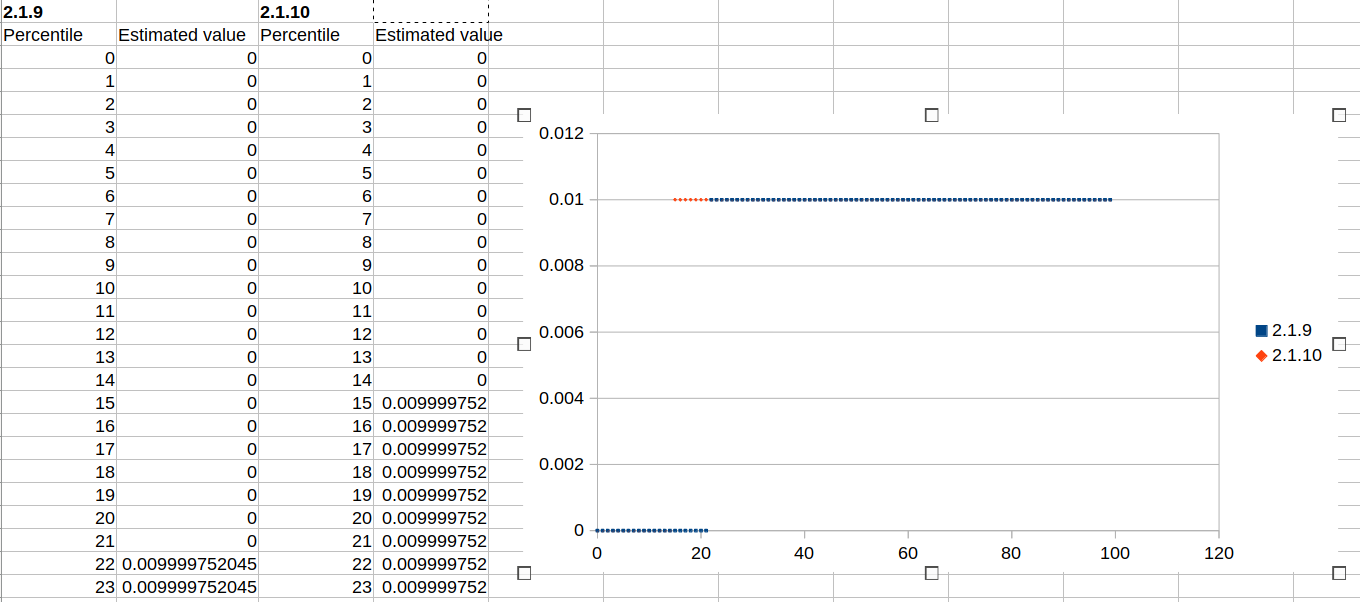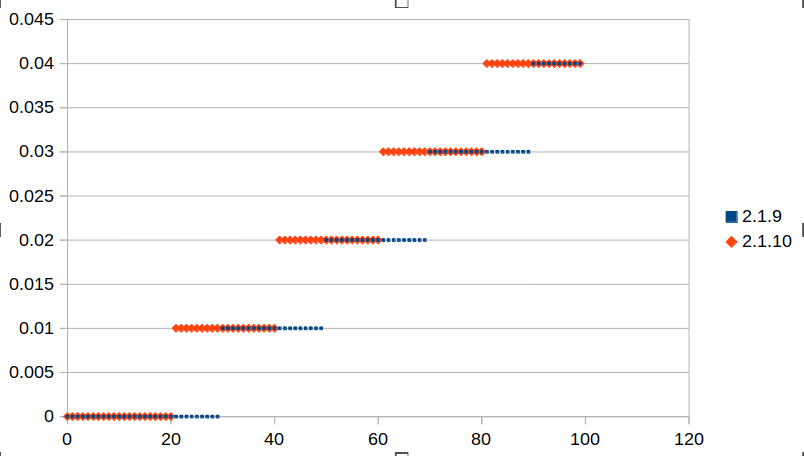HdrHistogram
HdrHistogram: A High Dynamic Range (HDR) Histogram
This repository currently includes a Java implementation of HdrHistogram. C, C#/.NET, Python, Javascript, Rust, Erlang, and Go ports can be found in other repositories. All of which share common concepts and data representation capabilities. Look at repositories under the HdrHistogram organization for various implementations and useful tools.
Note: The below is an excerpt from a Histogram JavaDoc. While much of it generally applies to other language implementations as well, some details may vary by implementation (e.g. iteration and synchronization), so you should consult the documentation or header information of the specific API library you intend to use.
HdrHistogram supports the recording and analyzing of sampled data value counts across a configurable integer value range with configurable value precision within the range. Value precision is expressed as the number of significant digits in the value recording, and provides control over value quantization behavior across the value range and the subsequent value resolution at any given level.
For example, a Histogram could be configured to track the counts of observed integer values between 0 and 3,600,000,000 while maintaining a value precision of 3 significant digits across that range. Value quantization within the range will thus be no larger than 1/1,000th (or 0.1%) of any value. This example Histogram could be used to track and analyze the counts of observed response times ranging between 1 microsecond and 1 hour in magnitude, while maintaining a value resolution of 1 microsecond up to 1 millisecond, a resolution of 1 millisecond (or better) up to one second, and a resolution of 1 second (or better) up to 1,000 seconds. At its maximum tracked value (1 hour), it would still maintain a resolution of 3.6 seconds (or better).
The HdrHistogram package includes the Histogram implementation, which tracks value counts in long fields, and is expected to be the commonly used Histogram form. IntHistogram and ShortHistogram, which track value counts in int and short fields respectively, are provided for use cases where smaller count ranges are practical and smaller overall storage is beneficial.
HdrHistogram is designed for recording histograms of value measurements in latency and performance sensitive applications. Measurements show value recording times as low as 3-6 nanoseconds on modern (circa 2012) Intel CPUs. AbstractHistogram maintains a fixed cost in both space and time. A Histogram's memory footprint is constant, with no allocation operations involved in recording data values or in iterating through them. The memory footprint is fixed regardless of the number of data value samples recorded, and depends solely on the dynamic range and precision chosen. The amount of work involved in recording a sample is constant, and directly computes storage index locations such that no iteration or searching is ever involved in recording data values.
A combination of high dynamic range and precision is useful for collection and accurate post-recording analysis of sampled value data distribution in various forms. Whether it's calculating or plotting arbitrary percentiles, iterating through and summarizing values in various ways, or deriving mean and standard deviation values, the fact that the recorded data information is kept in high resolution allows for accurate post-recording analysis with low [and ultimately configurable] loss in accuracy when compared to performing the same analysis directly on the potentially infinite series of sourced data values samples.
A common use example of HdrHistogram would be to record response times in units of microseconds across a dynamic range stretching from 1 usec to over an hour, with a good enough resolution to support later performing post-recording analysis on the collected data. Analysis can include computing, examining, and reporting of distribution by percentiles, linear or logarithmic value buckets, mean and standard deviation, or by any other means that can can be easily added by using the various iteration techniques supported by the Histogram. In order to facilitate the accuracy needed for various post-recording analysis techniques, this example can maintain a resolution of ~1 usec or better for times ranging to ~2 msec in magnitude, while at the same time maintaining a resolution of ~1 msec or better for times ranging to ~2 sec, and a resolution of ~1 second or better for values up to 2,000 seconds. This sort of example resolution can be thought of as "always accurate to 3 decimal points." Such an example Histogram would simply be created with a highestTrackableValue of 3,600,000,000, and a numberOfSignificantValueDigits of 3, and would occupy a fixed, unchanging memory footprint of around 185KB (see "Footprint estimation" below).
Histogram variants and internal representation
The HdrHistogram package includes multiple implementations of the AbstractHistogram class:
Histogram, which is the commonly used Histogram form and tracks value counts in long fields.IntHistogramandShortHistogram, which track value counts in int and short fields respectively, are provided for use cases where smaller count ranges are practical and smaller overall storage is beneficial (e.g. systems where tens of thousands of in-memory histogram are being tracked).AtomicHistogramandSynchronizedHistogram(see 'Synchronization and concurrent access' below)
Internally, data in HdrHistogram variants is maintained using a concept somewhat similar to that of floating point number representation: Using an exponent a (non-normalized) mantissa to support a wide dynamic range at a high but varying (by exponent value) resolution. AbstractHistogram uses exponentially increasing bucket value ranges (the parallel of the exponent portion of a floating point number) with each bucket containing a fixed number (per bucket) set of linear sub-buckets (the parallel of a non-normalized mantissa portion of a floating point number). Both dynamic range and resolution are configurable, with highestTrackableValue controlling dynamic range, and numberOfSignificantValueDigits controlling resolution.
Synchronization and concurrent access
In the interest of keeping value recording cost to a minimum, the commonly used Histogram class and its IntHistogram and ShortHistogram variants are NOT internally synchronized, and do NOT use atomic variables. Callers wishing to make potentially concurrent, multi-threaded updates or queries against Histogram objects should either take care to externally synchronize and/or order their access, or use the ConcurrentHistogram, AtomicHistogram, or SynchronizedHistogram or variants.
A common pattern seen in histogram value recording involves recording values in a critical path (multi-threaded or not), coupled with a non-critical path reading the recorded data for summary/reporting purposes. When such continuous non-blocking recording operation (concurrent or not) is desired even when sampling, analyzing, or reporting operations are needed, consider using the Recorder and SingleWriterRecorder recorder variants that were specifically designed for that purpose. Recorders provide a recording API similar to Histogram, and internally maintain and coordinate active/inactive histograms such that recording remains wait-free in the presence of accurate and stable interval sampling.
It is worth mentioning that since Histogram objects are additive, it is common practice to use per-thread non-synchronized histograms or SingleWriterRecorders, and using a summary/reporting thread to perform histogram aggregation math across time and/or threads.
Iteration
Histograms supports multiple convenient forms of iterating through the histogram data set, including linear, logarithmic, and percentile iteration mechanisms, as well as means for iterating through each recorded value or each possible value level. The iteration mechanisms are accessible through the HistogramData available through getHistogramData(). Iteration mechanisms all provide HistogramIterationValue data points along the histogram's iterated data set, and are available for the default (corrected) histogram data set via the following HistogramData methods:
percentiles: AnIterable<HistogramIterationValue>through the histogram using a PercentileIteratorlinearBucketValues: AnIterable<HistogramIterationValue>through the histogram using a LinearIteratorlogarithmicBucketValues: AnIterable<HistogramIterationValue>through the histogram using a LogarithmicIteratorrecordedValues: AnIterable<HistogramIterationValue>through the histogram using a RecordedValuesIteratorallValues: AnIterable<HistogramIterationValue>through the histogram using a AllValuesIterator
Iteration is typically done with a for-each loop statement. E.g.:
for (HistogramIterationValue v :
histogram.getHistogramData().percentiles(ticksPerHalfDistance)) {
...
}
or
for (HistogramIterationValue v :
histogram.getRawHistogramData().linearBucketValues(unitsPerBucket)) {
...
}
The iterators associated with each iteration method are resettable, such that a caller that would like to avoid allocating a new iterator object for each iteration loop can re-use an iterator to repeatedly iterate through the histogram. This iterator re-use usually takes the form of a traditional for loop using the Iterator's hasNext() and next() methods.
So to avoid allocating a new iterator object for each iteration loop:
PercentileIterator iter =
histogram.getHistogramData().percentiles().iterator(ticksPerHalfDistance);
...
iter.reset(percentileTicksPerHalfDistance);
for (iter.hasNext() {
HistogramIterationValue v = iter.next();
...
}
Equivalent Values and value ranges
Due to the finite (and configurable) resolution of the histogram, multiple adjacent integer data values can be "equivalent". Two values are considered "equivalent" if samples recorded for both are always counted in a common total count due to the histogram's resolution level. HdrHistogram provides methods for determining the lowest and highest equivalent values for any given value, as well as determining whether two values are equivalent, and for finding the next non-equivalent value for a given value (useful when looping through values, in order to avoid a double-counting count).
Corrected vs. Raw value recording calls
In order to support a common use case needed when histogram values are used to track response time distribution, Histogram provides for the recording of corrected histogram value by supporting a recordValueWithExpectedInterval() variant is provided. This value recording form is useful in [common latency measurement] scenarios where response times may exceed the expected interval between issuing requests, leading to "dropped" response time measurements that would typically correlate with "bad" results.
When a value recorded in the histogram exceeds the expectedIntervalBetweenValueSamples parameter, recorded histogram data will reflect an appropriate number of additional values, linearly decreasing in steps of expectedIntervalBetweenValueSamples, down to the last value that would still be higher than expectedIntervalBetweenValueSamples.
To illustrate why this corrective behavior is critically needed in order to accurately represent value distribution when large value measurements may lead to missed samples, imagine a system for which response times samples are taken once every 10 msec to characterize response time distribution. The hypothetical system behaves "perfectly" for 100 seconds (10,000 recorded samples), with each sample showing a 1msec response time value. At each sample for 100 seconds (10,000 logged samples at 1 msec each). The hypothetical system then encounters a 100 sec pause during which only a single sample is recorded (with a 100 second value). The raw data histogram collected for such a hypothetical system (over the 200 second scenario above) would show ~99.99% of results at 1 msec or below, which is obviously "not right". The same histogram, corrected with the knowledge of an expectedIntervalBetweenValueSamples of 10msec will correctly represent the response time distribution. Only ~50% of results will be at 1 msec or below, with the remaining 50% coming from the auto-generated value records covering the missing increments spread between 10msec and 100 sec.
Data sets recorded with and without an expectedIntervalBetweenValueSamples parameter will differ only if at least one value recorded with the recordValue method was greater than its associated expectedIntervalBetweenValueSamples parameter. Data sets recorded with an expectedIntervalBetweenValueSamples parameter will be identical to ones recorded without it if all values recorded via the recordValue calls were smaller than their associated (and optional) expectedIntervalBetweenValueSamples parameters.
When used for response time characterization, the recording with the optional expectedIntervalBetweenValueSamples parameter will tend to produce data sets that would much more accurately reflect the response time distribution that a random, uncoordinated request would have experienced.
Footprint estimation
Due to its dynamic range representation, Histogram is relatively efficient in memory space requirements given the accuracy and dynamic range it covers. Still, it is useful to be able to estimate the memory footprint involved for a given highestTrackableValue and numberOfSignificantValueDigits combination. Beyond a relatively small fixed-size footprint used for internal fields and stats (which can be estimated as "fixed at well less than 1KB"), the bulk of a Histogram's storage is taken up by its data value recording counts array. The total footprint can be conservatively estimated by:
largestValueWithSingleUnitResolution =
2 * (10 ^ numberOfSignificantValueDigits);
subBucketSize =
roundedUpToNearestPowerOf2(largestValueWithSingleUnitResolution);
expectedHistogramFootprintInBytes = 512 +
({primitive type size} / 2) *
(log2RoundedUp((highestTrackableValue) / subBucketSize) + 2) *
subBucketSize
A conservative (high) estimate of a Histogram's footprint in bytes is available via the getEstimatedFootprintInBytes() method.




